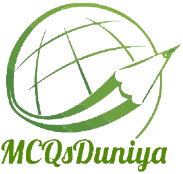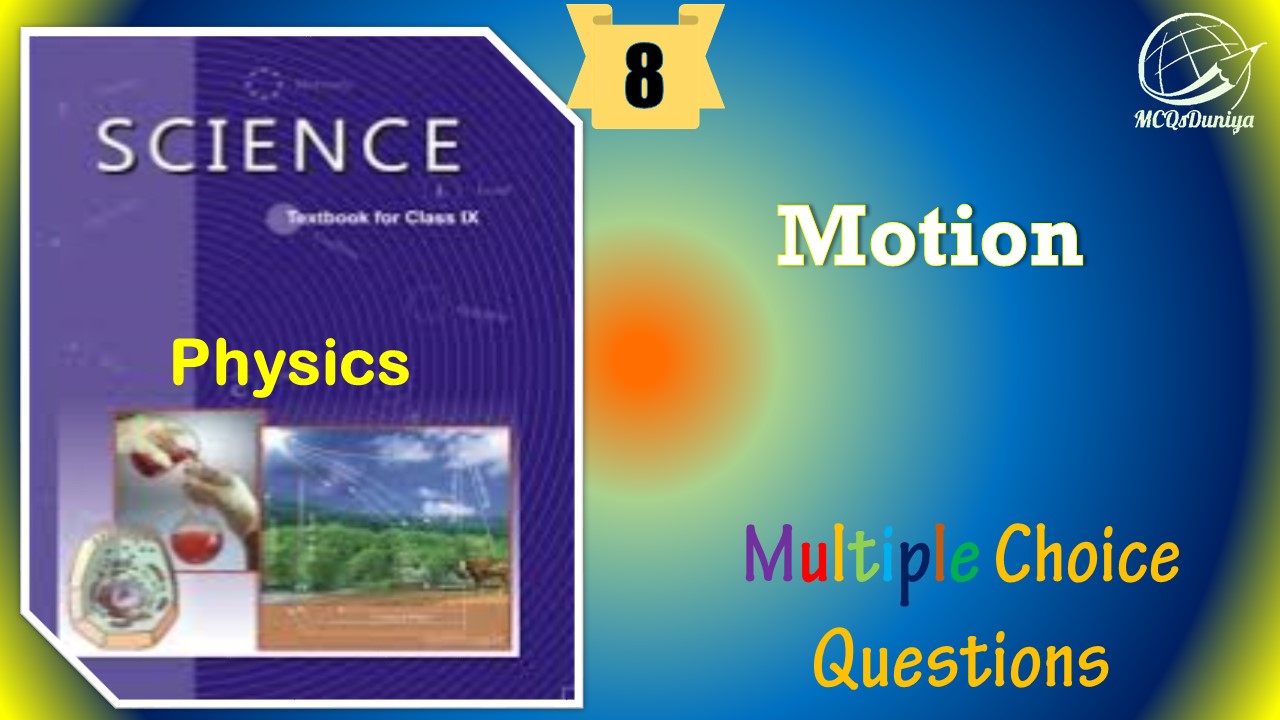Class 9 Science MCQ Motion with Answers is Prepared Based on Latest Exam Pattern. Students can solve NCERT Class 9 Science MCQ Motion with Answers to know their preparation level.
Students who are searching for NCERT Class 9 Science MCQ Motion with Answers are compiled here to get good practice on all fundamentals. Know your preparation level on MCQ Questions for Class 9 Science MCQ Motion with Answers. You can also verify your answers from the provided Class 9 Science MCQ Motion with Answers. So, ace up your preparation with MCQ of Class 9 Science MCQ & NCERT Textbook solutions Examinations.
NCERT Class 9 Science MCQ Motion with Answers
Question :Who gave the equations of motion for the first time?
(a) Bernhard Nobel
(b) Issac Newton
(c) C. V. Raman
(d) Einstein
Answer : (b) Issac NewtonShow Answer :
Question :The displacement of the object in a unit time is called:
(a) speed
(b) velocity
(c) acceleration
(d) average speed
Answer : (b) velocityShow Answer :
Question :The rate of change of velocity per second is known as:
(a) acceleration
(b) speed
(c) average velocity
(d) linear motion
Answer : (a) accelerationShow Answer :
Question :If the velocity of an object changes from an initial value u to the final value v in time t, the acceleration a will be:
(a) a =
(b) a =
(c) a =
(d) a =
Answer : (a) a = Show Answer :
Question :What is the unit of acceleration?
(a) m/s
(b) m/s2
(c) ms
(d) m/s3
Answer : (b) m/s2Show Answer :
Question :The unit of speed and velocity both is:
(a) ms-1
(b) ms-2
(c) ms2
(d) ms
Answer : (a) ms-1Show Answer :
Question :A particle is moving in a circular path of radius r. The displacement after half a circle would be:
(a) zero
(b) πr
(c) 2r
(d) 2πr
Answer : (c) 2rShow Answer :
Question :A body is thrown vertically upward with velocity u, the greatest height h to which it will rise is:
(a) u/g
(b) u2/2g
(c) u2/g
(d) u/2g
Answer : (b) u2/2gShow Answer :
Question :The slope of a velocity-time graph gives:
(a) the distance
(b) the displacement
(c) the acceleration
(d) the speed
Answer : (c) the accelerationShow Answer :
Question :If the displacement of an object is proportional to the square of time, then the object moves with:
(a) uniform velocity
(b) uniform acceleration
(c) increasing acceleration
(d) decreasing acceleration
Answer : (b) uniform accelerationShow Answer :
Question : The displacement of the object in a unit time is called:
(a) speed
(b) velocity
(c) acceleration
(d) average speed
Answer :(b) velocityShow Answer :
Question : Which of the following statement is correct regarding velocity and speed of a moving body?
(a) Velocity of a moving body is always higher than its speed
(b) Speed of a moving body is always higher than its velocity
(c) Speed of a moving body is its velocity in a given direction
(d) Velocity of a moving body is its speed in a given direction
Answer :(d) Velocity of a moving body is its speed in a given directionShow Answer :
Question : The numerical ratio of displacement to distance for a moving object is
(a) always less than 1
(b) always equal to 1
(c) always more than 1
(d) equal or less than 1
Answer :(d) equal or less than 1Show Answer :
Question : The slope of the distance-time graph is:
(a) Distance
(b) acceleration
(c) Speed
(d) Displacement
Answer :(c) SpeedShow Answer :
Question : The numerical ratio of displacement to distance for a moving object is :
(a) always less than 1
(b) equal to 1 or more than 1
(c) always more than 1
(d) equal to 1 or less than 1
Answer :(d) equal to 1 or less than 1Show Answer :
Question : Speed of 90 km/h when expressed in m/s is
(a) 2.5
(b) 90000
(c) 250
(d) 25
Answer :(d) 25Show Answer :
Question : The rate of change of velocity per second is known as:
(a) acceleration
(b) speed
(c) average velocity
(d) linear motion
Answer :(a) accelerationShow Answer :
Question : Which of the following is most likely not a case of uniform circular motion?
(a) Motion of the earth around the sun
(b) Motion of a toy train on a circular track
(c) Motion of a racing car on a circular track
(d) Motion of hours’ hand on the dial of a clock
Answer :(c) Motion of a racing car on a circular trackShow Answer :
Question : If the displacement of an object is proportional to square of time, then the object moves with
(a) uniform velocity
(b) uniform acceleration
(c) increasing acceleration
(d) decreasing acceleration
Answer :(b) uniform accelerationShow Answer :
Question : Which of the following is a correct measure of velocity?
(a) 30 s
(b) 30 m/s
(c) 30 South
(d) 30 m/s, South
Answer :(d) 30 m/s, SouthShow Answer :
Question : The speed of a moving object is determined to be 0.06 m/s. This speed is equal to :
(a) 2.16 km/h
(b) 1.08 km/h
(c) 0.216 km/h
(d) 0.0216 km/h
Answer :(d) 0.0216 km/hShow Answer :
Question : A person travels distance πR along the circumference of a circle of radius R. Displacement of the person is
(a) R
(b) 2R
(c) 2πR
(d) zero
Answer :(b) 2RShow Answer :
Question : What is the unit of acceleration?
(a) m/s
(b) m/s²
(c) ms
(d) m/s³
Answer :(b) m/s²Show Answer :
Question : A car is travelling at a speed of 90 km/h. Brakes are applied so as to produce a uniform acceleration of – 0.5 m/s². Find how far the car will go before it is brought to rest?
(a) 8100 m
(b) 900 m
(c) 625 m
(d) 620 m
Answer :(c) 625 mShow Answer :
Question : Area under a υ -1 graph represents a physical quantity which has the unit
(a) m²
(b) m
(c) m³
(d) ms-1
Answer :(b) mShow Answer :
Question : The S.I. unit of acceleration is:
(a) ms-²
(b) ms
(c) ms²
(d) m
Answer :(c) ms²Show Answer :
Question : When a car driver travelling at a speed of 10 m/s applies brakes and brings the car to rest in 20 s, then retardation will be :
(a) + 2 m/s²
(b) – 2 m/s²
(c) – 0.5 m/s²
(d) + 0.5 m/s²
Answer :(d) + 0.5 m/s²Show Answer :
Question : Name the instrument used to measure instantaneous speed of a vehicle
(a) multimeter
(b) ammeter
(c) speedometer
(d) accelerator
Answer :(c) speedometerShow Answer :
Question : The slope of a velocity-time graph gives:
(a) the distance
(b) the displacement
(c) the acceleration
(d) the speed
Answer :(c) the accelerationShow Answer :
Question : The numerical ratio of displacement to distance for a moving object is:
(a) Always less than 1
(b) Equal to 1 or less than 1
(c) Always more than 1
(d) Equal to 1 or more than one
Answer :(b) Equal to 1 or less than 1Show Answer :
Question : In which of the following cases of motions, the distance moved and the magnitude of displacement are equal?
(a) If the car is moving on a straight road
(b) If the car is moving in Circular path
(c) The pendulum is moving to and fro
(d) The earth is revolving around the sun.
Answer :(a) If the car is moving on a straight roadShow Answer :
Question : A boy throws a ball up and catches it when the ball falls back. In which part of the motion the ball is accelerating?
(a) During downward motion
(b) When the ball comes to rest
(c) During upward motion
(d) When the boy catches the ball
Answer :(a) During downward motionShow Answer :
Question : If the displacement of an object is proportional to the square of time, then the object moves with:
(a) uniform velocity
(b) uniform acceleration
(c) increasing acceleration
(d) decreasing acceleration
Answer :(b) uniform accelerationShow Answer :
Question : The ratio of speed to the magnitude of velocity when the body is moving in one direction is
(a) Less than one
(b) Greater than one
(c) Equal to one
(d) Greater than or equal to one
Answer :(c) Equal to onShow Answer :
Question : 180° plane angle is equal to
(a) π/2 radian
(b) π radian
(c) 2π radian
(d) none of these
Answer :(b) π radianShow Answer :
Question : The ratio of the heights from which two bodies are dropped is 3:5 respectively. The ratio of their final velocities is:
(a) 9: 25
(b) √ 3: √ 5
(c) 5 : 3
(d) √5 : √3
Answer :(b) √ 3: √ 5Show Answer :
Question : A racing car has a uniform acceleration of 6 m/s². In 10s it will cover:
(a) 300m
(b) 100m
(c) 200m
(d) 350m
Answer :(a) 300mShow Answer :
Question : Speed of a body in particular direction can be called
(a) acceleration
(b) displacement
(c) velocity
(d) distance
Answer :(c) velocityShow Answer :
Question : The slope of distance – time graph gives instantaneous.
(a) acceleration
(b) speed
(c) velocity
(d) Distance covered
Answer :(b) speedShow Answer :
Question : If a moving body comes to rest, then its acceleration is-
(a) positive
(b) both of these depending upon the initial velocity
(c) negative
(d) zero
Answer :(c) negativeShow Answer :
Question : At the maximum height, a body thrown vertically upwards has
(a) velocity not zero but acceleration zero.
(b) acceleration not zero but velocity zero.
(c) both acceleration and velocity not zero.
(d) both acceleration and velocity zero.
Answer 😀Show Answer :
Question : The magnitude of speed and velocity of a body is equal only if the body moves along a
(a) straight line.
(b) circular path.
(c) zigzag path.
(d) curved path.
Answer :AShow Answer :
Question : A car moving on a straight road is said to possess
(a) rectilinear motion.
(b) rotatory motion.
(c) rotatory motion.
(d) both a and b.
Answer 😀Show Answer :
Question : A body is moving along a circular path of radius r. The displacement of the body when it completes half a revolution is
(a) 0
(b) 2r
(c) πr
(d) 2πr
Answer :BShow Answer :
Question : The SI unit of retardation is
(a) m s–1
(b) m s–2
(c) m s2
(d) m
Answer :BShow Answer :
Question : For uniform motion
(a) the distance–time graph is a straight line parallel to the time axis.
(b) the speed–time graph is a straight line inclined to time axis.
(c) the speed–time graph is a straight line parallel to time axis.
(d) the acceleration–time graph is a straight parallel to time axis.
Answer :CShow Answer :
Question : For a body moving with a constant speed along a circular path, the direction of the velocity is
(a) horizontal.
(b) perpendicular to the radius.
(c) along the tangent to the circle.
(d) constant.
Answer :CShow Answer :
Question : A stone tied to a thread and whirled in a circular path is an example of
(a) circular motion.
(b) rotatory motion.
(c) rectilinear motion.
(d) uniform circular motion.
Answer 😀Show Answer :
Question : For a uniformly retarded motion, the velocity–time graph is
(a) a curve.
(b) a straight line parallel to time axis.
(c) a straight line perpendicular to time axis.
(d) a straight line inclined to time axis.
Answer 😀Show Answer :
Question : When a body travels in a straight line and its velocity changes by equal amounts in equal intervals of time, it is said to have
(a) uniform velocity.
(b) non-uniform acceleration.
(c) uniform acceleration.
(d) uniform speed.
Answer :CShow Answer :
Question : Which is a vector quantity?
(a) Weight
(b) Mass
(c) Density
(d) Volume
Answer :AShow Answer :
Question : A shot-put thrown by an athlete is said to be in
(a) rectilinear motion.
(b) rotatory motion.
(c) curvilinear motion.
(d) oscillatory motion.
Answer :CShow Answer :
Question : The average velocity of a body is equal to mean of its initial velocity and final velocity. The acceleration of the body is
(a) variable.
(b) zero.
(c) negative.
(d) uniform.
Answer 😀Show Answer :
Question : The slope of a speed–time graph gives
(a) velocity.
(b) acceleration.
(c) displacement.
(d) distance travelled.
Answer :BShow Answer :
Question : A free-falling stone under the action of gravity exhibits a
(a) uniform motion.
(b) non-uniform motion.
(c) zigzag motion.
(d) curvilinear motion.
Answer :BShow Answer :
Question : The device fitted in an automobile to measure the distance travelled by it is
(a) odometer.
(b) speedometer.
(c) hygrometer.
(d) ticker tape timer.
Answer :AShow Answer :
Question : The area under a speed–time graph represents a physical quantity which has the unit of
(a) m
(b) m2
(c) m s–1
(d) m s–2
Answer :BShow Answer :
Question : A body dropped from the top of a tower reaches the ground in 4 seconds. What is the height of the tower, if g = 10 m s–2?
(a) 78 m
(b) 70 m
(c) 80 m
(d) 90 m
Answer :CShow Answer :
Question : A sprinter is running along the circumference of the sports ground with constant speed. Which of the following is changing?
(a) Magnitude of acceleration
(b) Distance covered
(c) Force acting on the sprinter
(d) Direction of motion
Answer 😀Show Answer :
Question : A bus starting from rest moves with uniform acceleration of 0.1 m/s2for 2 minutes. The distance covered by the bus is
(a) 720 m.
(b) 620 m.
(c) 320 m.
(d) 520 m.
Answer :AShow Answer :
Question : The distance travelled by a body moving in a circular path is
(a) πr2
(b) 2πr
(c) πr
(d) 2πr2
Answer :BShow Answer :
Question : If a body takes time t to complete one round of the circular path of radius r, then the speed of the body (v) is given by
(a) v = πr × t
(b) v = πr/t
(c) 2πr/t
(d) 2πr × t
Answer :CShow Answer :
Question : A body falling freely under gravity shows a
(a) uniform acceleration.
(b) non-uniform acceleration.
(c) uniform velocity.
(d) variable velocity.
Answer :AShow Answer :
Question : Which is not the correct equation of motion?
(a) s = ut + (1/2)at2
b. v2– u2= 2as
(c) v = u – at
(d) v – u = at
Answer :CShow Answer :
Question : If a bus decreases its speed from 80 km/h to 60km/h, then its retardation is
(a) 11.1 m s–2
(b) 1.11 m s–2
(c) –1.11 m s–2
(d) 111 m s–2
Answer :BShow Answer :
Question : A ship is moving at a speed of 56 km/h. One second later it is moving at 58 km/h, then its acceleration is
(a) 72 km h–2
(b) 720 km h–2
(c) 7200 km h–2
(d) 7.2 km h–2
Answer :CShow Answer :
Question : If a driver decreases the speed of a car from 25 m/s to 10 m/s in 5 seconds, the acceleration produced by the car is
(a) –3 m s–2
(b) 3 m s–2
(c) 5 m s–2
(d) 7 m s–2
Answer :AShow Answer :
Question : When a car driver travelling at a speed of 10 m/s applies brakes and brings the car to rest in 20 s, the retardation will be
(a) +2 m s–2
(b) –2 m s–2
(c) –0.5 m s–2
(d) + 0.5 m s–2
Answer 😀Show Answer :
Question : The distance–time graph of a body having non-uniform motion is a
(a) straight line parallel to time axis.
(b) straight line perpendicular to time axis.
(c) curved line.
(d) zigzag line.
Answer :CShow Answer :
Question : If a body covers equal distances in equal intervals of time in a particular direction, the body is said to have a
(a) uniform velocity.
(b) non-uniform speed.
(c) uniform speed.
(d) variable velocity.
Answer :AShow Answer :
Fill in the Blanks.
Question :Newton’s ________ law is based on the concept of inertia.
Answer : firstShow Answer :
Question :Negative acceleration is known as __________
Answer : retardationShow Answer :
Question :If the path of a moving object is a straight line then, such a motion is known as a _________
Answer : linear motionShow Answer :
Question :_______ and ______ laid down the scientific foundation of concept of motion.
Answer : Galileo, NewtonShow Answer :
Question :Velocity is _______ quantity.
Answer : vectorShow Answer :
Question :During the uniform motion of an object along a straight line, the velocity remains _______ with time.
Answer : constantShow Answer :
Question :The initial velocity of an object moving from the position of rest is _________
Answer : zeroShow Answer :
Question :The displacement of the object in a unit time is called __________
Answer : velocityShow Answer :
True/False.
Question :Acceleration is a measure of the change in the velocity of an object per unit of time.
Answer : TrueShow Answer :
Question :The acceleration of an object is indirectly proportional to the net applied force.
Answer : FalseShow Answer :
Question :Motion is a change of position, it can be described in terms of the distance moved or the displacement.
Answer : TrueShow Answer :
Question :The simplest type of motion is the motion along a straight line.
Answer : TrueShow Answer :
Question :Automobiles are fitted with a device that shows the distance travelled. Such a device is known as an odometer.
Answer : TrueShow Answer :




